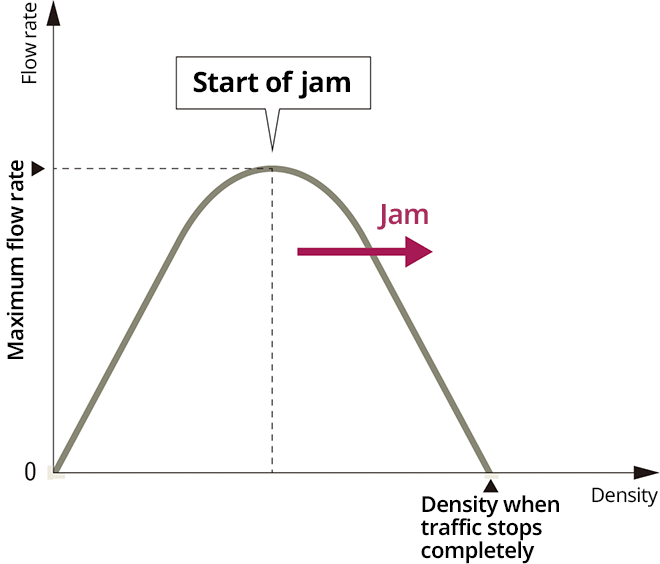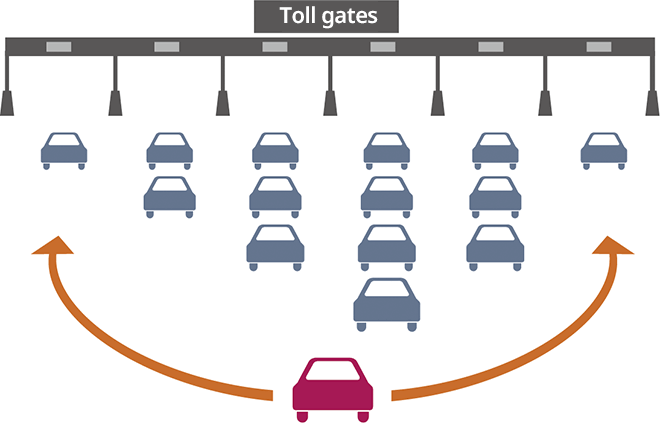Logistics View“Flow Rate” and “Density” Are the Key to Solving Jams—Unraveling Logistics Issues through Jamology
Jams can occur anywhere, on roads to tourist resorts, on commuter routes during rush hours, or near construction. Professor Katsuhiro Nishinari of the University of Tokyo calls the studying of this phenomenon “jamology,” and researches it from a scientific perspective. Defining jams and handling them in a scientific way can provide hints in solving issues not only related to traffic but also in fields such as logistics and production. We asked the professor about jams and the mechanisms to alleviate them.

Professor at the Research Center for Advanced Science and Technology, University of Tokyo
Katsuhiro Nishinari
Why did you become interested in “jamming”?
People routinely say things like “I got caught up in a traffic jam today,” but what is the basis of what situations are referred to as jams? Are we all just using the word “jam” instinctively without any criteria or boundaries?
When I was a student, I studied fluid dynamics and came across an essay that said, “the flow of vehicles is similar to the flow of water,” and that really opened my eyes. I realized that traffic could be perceived to be flow in society just as water and air are perceived to be flow in fluid dynamics, and if it could be handled scientifically, then jamming could be solved. This was the starting point of my research 30 years ago.
View the image enlarged.

Fig. 1 Definition of jamming
What kind of things are necessary to define jamming?
The two concepts of “flow rate” and “density” are important. In the case of traffic, flow rate is how many vehicles pass through a certain location. On the other hand, density is how many vehicles are in a unit interval. Whether the vehicles are moving is irrelevant. To elucidate the relationship between these two different concepts, a graph can be plotted with flow rate (traffic rate) on the vertical axis and density on the horizontal axis (Fig. 1). At first, the graph rises to the right because the flow rate increases as the density increases. However, the flow rate reaches the peak at a certain point, and from then on, the graph falls to the right. This peak is the start of the jam. We understand that before the peak is the state without a jam and after the peak is the state with a jam.
Until recent years, jams could not be expressed in numerical form and were perceived instinctively by many people, but they can now be expressed as data. In the case of vehicles, the density is 25 vehicles per kilometer. That is around 70 km per hour if converted to speed, and around 40 m if converted to distance between vehicles. If maintaining 40 m between vehicles becomes difficult when traveling on an expressway, then you are in a traffic jam.
The definition of a jam, that is the relationship between flow rate and density, can be applied to not just traffic but any kind of flow. Since the flow rate always rises and then falls, logical measures can be taken if the current state is checked against a graph of states.
In the case of people, for example, the population density of 1.8 people per 1 m2 is the numerical value for the boundary point of a jam. Since a jam will occur once 1.8 persons are exceeded, you can attempt to improve the degree of satisfaction of a service or place if you devise measures to prevent that number from being exceeded.
The rule is “haste makes waste”
You carry out experiments related to traffic jams. What kinds of things have you learned from them?
I touched on this in the explanation I gave about the definition, but experiments have shown that rather than traveling packed close together on an expressway, people can travel at a faster pace overall if they maintain an appropriate distance between their vehicles (40 m). When the distance between vehicles decreases, the density increases, and this will cause a loss of balance with the flow rate. From there, it will develop into a jam.
In addition, in an experiment where driving in the slow lane closest to the shoulder during a jam was compared to actively trying to drive faster in the passing lane, we learned that vehicles that continue traveling in the slow lane can reach their goal sooner. Since there are many entrance and exit junctions, people imagine that it will take a long time, but once the entire expressway becomes congested, the number of vehicles switching to the passing lane in order to drive faster increases. Consequently, the density of vehicles in the passing lane increases, making a jam more likely to occur, while the traffic in the slow lane unexpectedly flows smoothly.
A similar thing occurs at toll gates on expressways. For a two-lane or three-lane expressway, plenty of toll gates are provided (Fig. 2). However, many vehicles head to the center as the distance to the gate is shorter, causing waiting lines there. When that happens, the gates on the far sides from the center are relatively uncongested.
View the image enlarged.

Fig. 2 “Haste makes waste” at toll gates
So even when we select the option that normally is the fastest, it may be the wrong choice.
The rule to follow is “haste makes waste,” but people rarely make choices based on it. Even if it is announced to take the following train when trains are running late due to commuter rush hours or an accident, many people still try to get on the train in front of them. If you think about this as an individual, you will attempt to force yourself onto the train because that will allow you to arrive at your destination sooner. However, since the act of getting on the train will lead to the train becoming even further delayed and make the overall congestion state worse, it is better to wait for the next train. On the level of the individual, the next train will often be less crowded so you may be able to travel more comfortably. I wish people were relaxed enough to have the leeway to not get on the packed train right in front of them.
Is there research into various other kinds of jams?
The results of research into ant jams have attracted attention. Ants move in a line, but it was discovered that jams do not occur. An ant secretes pheromones and deposits them here and there on the ground as it walks, and then the next ant follows it by relying on those pheromones. The pheromone concentration is fixed while the speed is fixed, if ants become packed closer together, the amount of pheromones deposited increases resulting in a higher concentration than normal. It is believed that the ants that have detected this adjust their speed so that an appropriate distance is maintained between them. I think this is a capacity to avoid congestion that ants have acquired through the evolutionary process.
That is amazing. We humans remain as tormented by jams as ever.
In addition to time loss, the disadvantages of jams also include the increased risk of accidents. The crush incident that occurred on a pedestrian overpass at a fireworks event in Akashi City in 2001 was caused by an abnormal increase in the density of pedestrians. Also, many people have died in incidents that have occurred in pilgrimages to Mecca where tens of thousands of people gather. In Itaewon in South Korea as well, a crowd crush resulted in the death of 158 people in 2022. It was caused by the people flowing in both directions exceeding the capacity of the alleyway. This incident may have been prevented if the flow had been appropriately controlled.
Jams just seem to be a problem, but are there fields where they are an advantage?
There are some fields. For example, as the economy can be defined as the flow of money, you could say that the flow does not jam for the poor. I began jamology because I hate jams, but I’d welcome a jam with respect to money (laughter).
Aiming for overall optimization by sharing appropriate information
Jams occur also in fields such as logistics and production.
Various work is carried out at logistics bases, including the arrival, unpacking, organizing, storing, picking, processing, inspection, packing, and shipment of goods. There is accumulated know-how and wisdom in each process, and we always strive to make it more efficient. However, there is a limit to the efforts of each process, as even if one of the processes improves its work speed, it will not always lead to more efficiency. If the next process is still carried out at the same speed, a jam will occur at the boundary between the previous process and next process, and a buffer will have to be implemented.
To alleviate congestion, it is important to look at this from the perspective of not partial optimization but overall optimization. Such a method is to first measure each work time individually. This will allow you to find areas that perform work especially quickly, and then reduce the processing speeds to match the slower operations so that the overall speed matches. It is certainly important to make efforts to improve the work speed, but if the work performed afterwards is slow, the final number of shipments will not increase, and the efficiency of the overall operation will not improve. If processes that perform work quickly reduce their speed, intermediate inventory will decrease. What is important is not increasing the speed but optimizing the overall operation.
Can you tell us about other cases where issues have been resolved by focusing on flow rate and density?
One such case is airports. When international flights arrive at an airport, the number of people in the airport increases suddenly and a jam will occur if the processing capacity of the immigration gates is exceeded. However, airlines already have relevant data including the number of passengers, number of foreigners, and amount of luggage. If the airport could receive such information beforehand, it could adjust its system to receive passengers accordingly. Airlines individually managed such data up until recently, but a move was made to share the information with Narita Airport, and the shifts of staff involved in immigration inspection began being organized based on it. Congestion at gates can be relieved by increasing the number of staff on days when many people will enter the country. In jamology terms, increasing the flow rate (i.e., the number of people passing through the gates) by increasing the number of staff can enable people to pass through the gates without a jam occurring even if the density (i.e., the congested state) is the same. Conversely, the number of staff can be reduced on days when fewer people will enter the country, leading to reform in the working hours of employees.
The comprehensive management of such information enables further alleviating of various jams. We all find work hard when it is amid uncertainty, but the burden can be reduced by forecasting the future. The same applies not just to airports but other industries as well.
Applied to logistics, can you tell us what kinds of information can be shared to help relieve jams?
In logistics as well, the sharing of information about supply chains is extremely effective. In logistics for retail stores, I have heard that the distribution of bargain goods advertised on leaflets is challenging. Bargains are an important strategy for retailers, and information about when and what will be sold at bargain prices is a business secret. However, for the logistics industry which faces serious problems with labor shortages, companies wish to obtain quickly even a little amount of information so that they can make preparations such as securing drivers. For example, if a logistics company was able to sign nondisclosure agreements with retailers and receive information about bargains 6 months in advance, it could make the necessary preparations.
Do you think that progress will be made with information sharing in the future?
Formerly, there was no need to worry about stock because whatever was produced was sold, but we are now in the age of high-mix low-volume production. We must now think about streamlining and overall optimization that goes beyond the framework of one company.
There exists the term “bullwhip effect.” When you swing a whip, even though the wave motion is small near your hand, it increases as it nears the tip of the whip. In the same way, if retailers attempt to keep a little more inventory, more inventory will need to be kept at intermediate distribution points, and manufacturers will have to increase production and inventory as well. Sharing information from retailers with the manufacturers can reduce the amount of unnecessary inventory.
Finally, please tell us about some of the tricks that can be used to avoid jams.
We know that jams are likely to occur at boundaries. If we look at the example of a factory, an elevator that carries things from the second floor to third floor is a boundary, and thus if the flow rate balance was to be lost there, a jam would occur instantly. When thinking about logistics within a factory, we should be aware of the points where jams are likely to occur to provide some space at boundaries. I believe there will be times when you should decide that, for example, something should not be carried to the third floor now, but the provided space will function as a buffer. Thinking about the problem from the perspective of overall optimization in this way is the trick to avoiding jams. Since the definition of a jam, that is the relationship between flow rate and density, can be applied to any kind of flow, it is possible to aim for the balance between flow rate and density at which jamming will not occur.

Katsuhiro Nishinari
Born in 1967. Earned a Ph.D. degree (engineering) upon finishing a doctor’s course at School of Engineering, The University of Tokyo. Became a Professor at the Research Center for Advanced Science and Technology, The University of Tokyo. Specialty is mathematical physics. Received the Kodansha Scientific Publication Award and Nikkei BP BizTech Book Award for “Jamology” (Shincho Sensho) in 2007. Selected for “Significant Contribution to Science and Technology 2013” by the Ministry of Education, Culture, Sports, Science and Technology in 2013. Won the Ig Nobel Prize for research regarding congestion caused by looking at smartphones while walking in 2021.
- *This article is based on the content of “Logistics View: “Flow Rate” and “Density” Are the Key to Solving Jams—Unraveling Logistics Issues through Jamology” featured in DAIFUKU NEWS No. 226 (published in January 2020).
